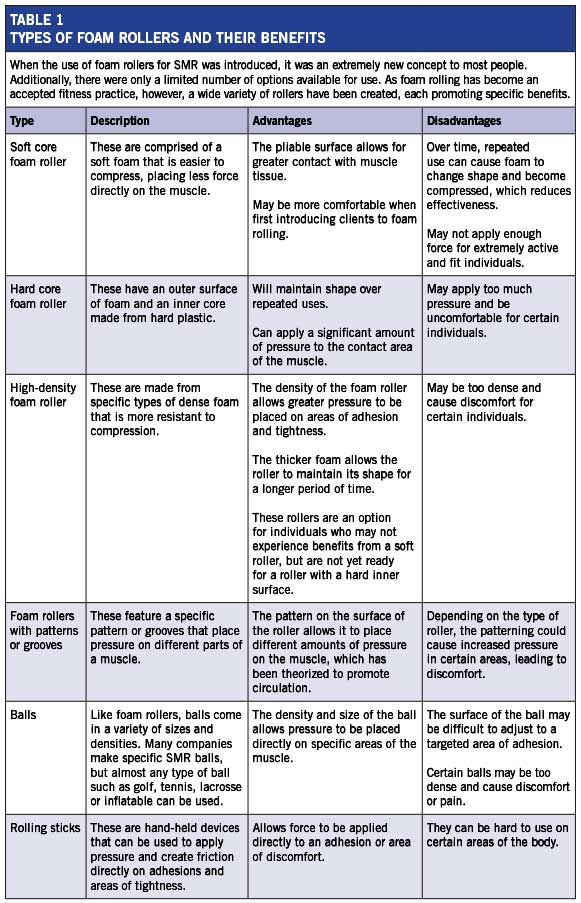ACE - Certified™: December 2016 - How and When to Use Foam Rollers and Myofascial Release in an Exercise Program (original) (raw)

Walk through almost any health club or training studio and you are likely to see individuals lying on the floor rolling around on a tubular piece of foam. In the recent past, self-myofascial release (SMR) and the use of foam rollers has been promoted as a way to reduce tension and increase muscle length during either the warm-up or cool-down phases of a workout. As a result, most fitness facilities now provide a wide variety of rollers for members to use, which means your clients are probably using them, too. To be able to provide your clients with accurate information and effective exercise solutions, you must have a clear understanding of exactly how using a foam roller provides the necessary stimulus on muscle tissue to reduce tension and change muscle length.
How Muscle Tightness Affects the Body
There are two specific components of a muscle: (1) the striated skeletal muscle comprised of the contractile element responsible for producing movement; and (2) the elastic fascia and connective tissue that is interwoven between the various layers of skeletal muscle. It’s important to note that striated skeletal muscle is enveloped by fascia and other connective tissue. When healthy, the entire structure can be pliable, easily allowing surrounding joints to move unrestricted through their structural ranges of motion (Schleip, 2015; Myers, 2014). If a muscle is overused for repetitive motions or held in a specific position during extended periods of inactivity, however, collagen can form between the layers of skeletal muscle, creating adhesions or knots that restrict the ability of muscle sheaths to slide against one another (MacDonald et al., 2013).
Collagen is a protein molecule bound in a triple-helix formation to give it rigidity. It is a component of the fascia that is produced in response to an applied mechanical stress. Ground substance is a collection of individual collagen molecules that comprise the extracellular matrix (ECM) surrounding individual muscle fibers. The ECM is a viscous fluid that can reduce friction as individual muscle fibers slide against one another.
When tissue is warm and moved frequently, the ECM becomes more gel-like, reducing friction and allowing easier movement between individual fibers. However, if tissue experiences a combination of dehydration and lack of movement, the ECM can become stickier, limiting the ability of fibers to slide against one another. If fibers remain inactive for a period of time, the collagen molecules of the ECM will actually bind together for stability, which can create an adhesion between the various layers of muscle (Schleip, 2015). When adhesions form they can cause a muscle to remain in a shortened position, which restricts its ability to lengthen and allow movement at a joint. Scar tissue is an example of how collagen produced by the ECM binds together to help a tissue regain its structure after an injury. Once a scar is formed, it can limit the ability of the tissue move through its normal range of motion (ROM), which can then impact normal joint function.
During normal movement and activity, collagen is produced parallel to muscle fibers to provide structure and elasticity, helping the tissue to be more resilient and less susceptible to a strain injury. Performing strength-training exercises through multiple planes of motions can help produce collagen that makes fascia capable of withstanding multidirectional strains (Myers, 2014). In healthy, functional muscle, the fascia allows the layers of muscle to slide against one another with minimal restrictions. Adhesions formed by collagen binding between layers of muscle can limit tissue extensibility and significantly reduce joint motion. If a muscle on one side of a joint is held in a shortened position, it can send an inhibitory signal, causing tissue on the other side of the joint to lengthen. This creates an imbalance of forces around a particular joint, which can change both joint structure and function. Changes in muscle length and joint structure can restrict normal movement patterns and be a cause of injury for active individuals.
Traditional massage therapy works by manually manipulating muscle tissue to break up collagen adhesions and realign the tissue to allow the layers to slide against one another unimpeded. Breaking up adhesions can help reduce muscle tightness and improve joint ROM. Unless you are a properly accredited massage therapist, however, it is outside of the scope of practice for a health and fitness professional to apply manual pressure in an effort to break up adhesions. And, because it is not practical to have the average client spend the time or money to work with a massage therapist prior to a workout, foam rollers are a means of applying pressure to break up and realign muscle as a component of the warm-up for exercise.
The Science Behind Foam Rolling
The pressure and motion of a muscle moving on a foam roller can help break up adhesions and realign muscle tissue to be able to function normally (Mauntel, Clark and Padua, 2014). In general, foam rollers provide the greatest response when an individual places a body part directly on top of the roller and moves rhythmically to apply pressure to the underlying muscle and elastic connective tissue.
There are two theories on why foam rolling works to alleviate muscle tightness:
- The first hypothesis on how foam rolling creates length change is based on the principle of autogenic inhibition, which happens when intrinsic sensory receptors—the Golgi tendon organ (GTO) and muscle spindle—identify changes within muscle tissue. The GTO senses tension placed on a muscle, while the spindle identifies length change and the rate of change within a particular muscle. Autogenic inhibition is the response that occurs as a muscle is placed under tension. The GTO senses the tension and sends a signal to the spindles to allow the muscle to lengthen. In the case of foam rolling, the pressure of the foam roller on the muscle increases tension on the muscle fibers, signaling the GTO to allow the muscle spindles and fibers to lengthen (Mauntel, Clark and Padua, 2014; Mohr, Long and Goad, 2014). (Note: This is also the basic physiological mechanism for how static stretching creates length change in muscles—an acute tension in the muscle leads to a neurological signal that allows the muscle to lengthen.)
- The second hypothesis for how SMR with foam rolling works is that is causes an increase of internal muscle temperature. Rolling muscle and connective tissue on a foam roller creates friction between the roller and the involved muscle. This elevated heat causes the tissue to become more gel-like, allowing it to be more pliable. Once tissue has greater extensibility, it is easier to lengthen, allowing surrounding joints to achieve a complete ROM free from restrictions (Mauntel, Clark and Padua, 2014; Healey et al., 2013, MacDonald et al., 2013).
It’s not 100 percent clear which theory is responsible for the outcome, but it has been shown that using myofascial foam rolling can lead to an increased muscle length, which, in turn, allows for greater joint ROM without a loss of strength.

Foam rolling, says Kyle Stull, the Education Content Manager for Trigger Point Therapy, which makes the GRID foam rollers, “may increase blood flow and elevate heat in the involved tissue. We’re not sure which is more responsible for changing muscle length, but we do know that using foam rollers may help individuals increase range of motion immediately after use.”
Using a foam roller for myofascial release can reduce muscle tension, which can help lengthen a muscle, but this is a short-term change in the architecture of the tissue. For best results, it is important to move through a ROM to ensure that the involved tissue can adequately use the change in extensibility and length. Stull points out that while foam rolling can lengthen tissue, it does not help improve joint ROM, which occurs as the result of the tissue having the ability to successfully lengthen and shorten to articulate a joint without any restrictions.
The benefits of using foam rollers include its ease of use and ability to provide an acute response for improving muscle length and joint motion. By contrast, a drawback to foam rollers is that the amount of pressure required to break up an adhesion can be uncomfortable or even painful for some clients. As with any mode of exercise, it’s important to understand both the advantages and disadvantages, and to identify the best practices for how it can be used with your clients.
In addition to years of anecdotal evidence of clients claiming to feel better after foam rolling, the evidence observed in the scientific literature suggests that using a foam roller for myofascial release may provide the following benefits (Mauntel, Clark and Padua, 2014; MacDonald et al., 2013; Healey et al., 2013; Shah and Bhalara, 2012):
- Reduce tissue tension, which allows muscles to experience an increase of joint range of motion.
- Reduce the risk of developing adhesions as the result of collagen binding between layers of muscle tissue.
- Help reduce soreness after an exercise session, which may enable individuals to recover in a shorter period of time.
- Help promote a feeling of relaxation after a workout, which is an important psychological benefit.
When to Use Foam Rollers for SMR
The natural inflammation that occurs during the tissue-repair process, combined with a lack of movement after an exercise session, could be a cause of muscle adhesions. Exercise-induced muscle damage signals the repair process—this is when new collagen molecules are formed to help repair and strength tissue. If tissue is not moved, the collagen could bind between layers of muscle. Muscle damage can change both the firing patterns of the motor units responsible for muscle contractions and the sequence in which muscles are recruited and engaged to produce a movement (MacDonald et al., 2013). Using a foam roller can help minimize the risk of the new collagen-forming adhesions between layers and possibly increase the speed of post-exercise recovery.
Additionally, using a foam roller for myofascial release during a warm-up may help reduce tension while elevating temperature in muscle and fascia without the use of any exercises that could cause fatigue (Healey et al., 2013). During a warm-up, it is important to only use the foam roller for a brief period of time to elevate tissue temperature and reduce tension. Applying pressure from a foam roller for an extended period of time could desensitize the muscle and affect its ability to contract during the workout.
“Using a foam roller before a workout can increase temperature and reduce tension, allowing greater joint motion,” explains Jeff Alexander, an Orange County, Calif.-based personal trainer who developed the Alexander Method of SMR. “But it is important to use for only a brief amount of time. You would not want a deep tissue massage before a workout because it could change a muscle’s ability to produce force. The same is true with a foam roller—too much pressure could reduce the effectiveness of the warm-up.”
When using a foam roller for myofascial release, Stull recommends moving at a consistent tempo of approximately 1 inch per second while remaining on areas of tension for up to 90 seconds to allow the tissue to relax and lengthen. Because SMR can help elevate tissue temperature, Stull will often have clients use a foam roller for active recovery between strength-training exercises during a workout.

MacDonald and colleagues (2014) compared a group of participants that used a foam roller after exercise to help reduce muscle tension with a group of participants that did not. Their observation was that the foam-rolling group experienced peak muscle soreness 24 hours after a workout while the control group experienced muscle soreness up to 48 hours after a workout. If using a foam roller can help reduce soreness and shorten the recovery time after a workout, it could allow clients to increase their training volume to maximize results.
Healey and colleagues (2013) also conducted a study on the use of foam rolling for recovery and observed: “Post-exercise fatigue after foam rolling was significantly less…the reduced feeling of fatigue may allow participants to extend acute workout time and volume, which could lead to chronic performance enhancement.”
A review of the research literature on the use of foam rolling for SMR by Mauntel, Clark and Padua (2014) revealed that applying foam rolling as a component of a warm-up can help reduce muscle tension without limiting a muscle’s ability to produce force. A reduction in muscle tension can help improve joint function, allowing optimal movement efficiency and enhanced muscle performance, both of which can help reduce the risk of injury during exercise. Their conclusions support Alexander’s belief that using a foam roller should be limited during warm-up. Furthermore, they observed that gains in joint ROM occurred after only 20 seconds of treatment, with more consistent results being demonstrated after 90 seconds to three minutes of treatment.

Conclusion
Foam rolling can be an important component of a pre-exercise warm-up and, for best results, it is best to limit the application of pressure to two minutes or less per muscle group. Alexander recommends using a foam roller only for muscles that demonstrate restrictions that change joint motion. “The best practice for using a foam roller is to reduce tension in the tissue, and then immediately perform multiplanar movements to help the tissue adapt to the new length while controlling joint function,” explains Alexander
Foam rolling can also be used effectively at the end of a workout to reduce muscle tension and promote recovery. It is up to you to identify the best time to apply foam rolling for each client’s specific needs. If SMR from a foam roller can help reduce muscle tension while promoting a feeling of relaxation, it could be beneficial to teach clients how to safely perform foam rolling movements on their own and urge them to invest in a foam roller that they can use at home on a regular basis.
As is the case with any exercise technique, some clients will love using a foam roller while others will just not be interested in rolling on a piece of foam, regardless of the potential benefits. The true art of personal training is knowing how and when to apply the science of the exercise tools that can make a difference in a client’s life.
References
Healey, K. et al. (2013). The effects of myofascial release with foam rolling on performance. Journal of Strength and Conditioning Research, 28, 1, 61-68.
MacDonald, G. et al. (2014). Foam rolling as a recovery tool after an intense bout of physical activity. Medicine & Science in Sports & Exercise, 46, 1, 131-142.
MacDonald, G. et al. (2013). An acute bout of self-myofascial release increases range of motion without a subsequent decrease in muscle activation or force. Journal of Strength and Conditioning Research, 27, 3, 812-821.
Mauntel, T., Clark, M. and Padua, D. (2014). Effectiveness of myofascial release therapies on physical performance measurements: A systematic review. Athletic Training & Sports Health Care. 6(4), 189-196.
Mohr, A., Long, B. and Goad, C. (2014). Effect of foam rolling and static stretching on passive hip-flexion range of motion. Journal of Sport Rehabilitation. 23, 296-299.
Myers, T. (2014). Anatomy Trains: Myofascial Meridians for Manual and Movement Therapists (3rd ed.). Elsevier, London.
Schleip, R. (2015). Fascia in Sport and Movement. Handspring, Scotland.
Shah, S. and Bhalara, A. (2012). Myofascial release. International Journal of Health Sciences and Research, 2, 2, 69-77.